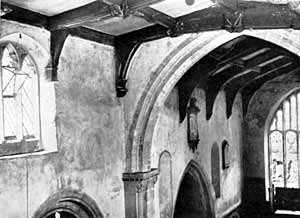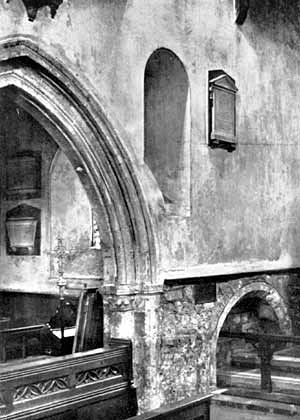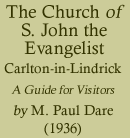The chancel

VIEW N.-E. FROM GALLERY. NOTE PERPENDICULAR ROOF CUTTING LINE OF CHANCEL ARCH; NORMAN PIER; AND NORMAN CHANCEL WINDOWS CUT INTO BY ARCH TO BECKET CHAPEL.

CHANCEL NORTH WALL—ARCH TO BECKET CHAPEL CUTTING INTO NORMAN WINDOW ; SO-CALLED "FOUNDER'S ARCH" BELOW.
Having passed through the arch from chapel to chancel, turn round and look at the north wall. Here it is at once seen that the arch of 1190 was pierced through the wall of 1070 to 1160 described earlier, for the arch cuts clean into the jamb-line of two deeply splayed early Norman windows, which formerly gave light to the chancel but now merely look into the chapel. A third such window, now entirely blocked up and invisible from the inside, lies still further east along the wall, and its outline may be viewed from the exterior. That the chancel preserves its original Norman dimensions is shown by the Norman angle-quoins outside, which should be compared with the similar quoins at the west end of the nave. The Norman chancel would be lit by three windows on the north, and three on the south, but the latter have all vanished in the weird clutter of vestry, vestry-porch and organ-chamber, added in the last century. The east window would, to judge by known examples, be of three or five tall, narrow lights, and in its place, about 1425, the present spacious Perpendicular window of five lights, split into ten in the upper portion, was substituted.* At the same time, the present window i n the south wall was substituted for a small Norman one.
In the north wall of the chancel, close to the floor, is a low arched recess, which is late medieval work. These recesses are often wrongly called "founder's arches," but it is rarely that they correspond even with any known date of a founder+; their most general use, though at church restorations they prove a tempting place to deposit a sepulchral slab or effigy, seems to have been for the Christmas crib and the representation of the Easter sepulchre, where no separate sepulchre of special form existed. Owing to the unhistorical way in which the altar is perched high on too many steps to-day, the arch is not so tall as it should be ; it is hoped ultimately, in accordance with medieval usage, to bring down the sanctuary to only one step above floor-level, and to replace the clumsy altar rails, erected about 1880.
Opposite the arch, in the south wall, is a double recess, with arched heads and a central dividing shaft, which may have been either a double piscina for Mass ablutions, or a combined piscina and aumbry. Which it was, it is impossible to say, as it seems to have been re-silled in the restorations of last century, and has lost its drain or drains.
Under the floor covering, just west of the unlovely altar-rails, are the following interesting sepulchral slabs :
1. Henry Bland :—Fermarius (bailiff) of Carlton manor, died 1483.
2. John Philips :—Rector, died 1646.
The translation of the latter reads : " Lest a fitting memorial should be lacking to John Philips, behold this whole church of Carlton, embellished moreover by the preaching therein of one hundred and three of his sermons, in turn rises up as his monument." As Philips was rector from 1646 to 1666, this gives an average of five sermons a year, which is little to boast about ! Nor is there any evidence that he did a single thing to beautify his church. His epitaph anticipates by over fifty years the idea contained in Wren's famous inscription in S. Paul's : Si monumentum requiris, circumspiee.
It may interest some, by the way, to record here that according to Dodsworth, Robert Ferrar, bishop of S. David's and " burned for religion," has a tomb in the church ; and that John Lake, one of the seven bishops clapped into the Tower by James II, was rector here, and is said to have been buried in the church.
Over the small Perpendicular priest's door in the chancel south wall, inserted about 1425, are the royal arms painted on canvas. Many churches possess such arms, they being ordered by Charles II to be displayed ; here the coat, which shows England, Scotland and Ireland, with the inescutcheon of Hanover, only dates from 1810 to 1815, as it has the Hanover electoral bonnet above the inescutcheon.
A pagan stone
Passing out now by the priest's door, we come into the vestry porch, built, with the vestry, at a cost of £100 in 1832. Over this door is preserved a remarkable relic of pagan Saxondom in Carlton—a stone upon which are carved in a semicircle, the sun, moon and stars, bordered by what may be stalks and heads of wheat or barley, in allusion to the sun's fertilising power—but from one angle this side-piece looks like a bird of the eagle class, with a fan-spread tail. A Christian cross has been cut later into the upper rim. The whole stone seems to have been adapted to form a tympanum, or round-headed filling for the head of a Norman doorway— probably an earlier, vanished priest's door of the sarne size on this site. So strong is folk-memory that village tradition to this day calls the stone the " sun-stone."
Frequently, Christian places of worship were erected on sites already sacred, and this may have been the case at Carlton. There exists a famous letter written in 601 a.D. by Pope Gregory to Mellitus, a Roman missionary in Britain, telling him not to destroy the heathen temples, but only the idols, and to preach the faith in groves and buildings already sacred, that it might take firmer root in the hearts of the people.
The exterior
Above the pagan stone is a coat of arms, much worn and unidentifiable, hence evidently exposed to the elements before the erection of the vestry porch ; the coat is of 15th or 16th century date, by the work. The visitor should here go out of the porch and turn left to inspect the Norman quoins of the chancel. There is no buttress at the north-east corner, but one at the southeast. Note that it is not truly bonded in, but was tacked on in the time of William de Chaumbre, as was also the buttress to which the vestry-porch side wall is clumsily joined. Neither buttress serves any useful purpose structurally, as, owing to its thickness, a Norman chancel end rarely required buttressing—this wall is 3 ft. thick. It is possible that the masons of c. 1420-11440, on putting in the big east window, thought the mass of walling at its sides might give—but if so, it is curious they did not put buttresses at both corners.
This east window, of five lights, split into ten in the head by the transoming, is, though disproportionate to the east wall, a good example of Perpendicular work, and is of the same period as the nave clerestory and parapets (though the latter and their pinnacles have been much altered about 1831). In the first half of the 15th century, the art of the worker in stained glass had reached such a stage of excellence that he could make larger quarries and panels, and he clamoured for more space than could be found in the earlier, narrow windows, and hence the craze for clerestories and larger windows. The window is a little later in style than the top stage of the tower, but Chaumbre was rector over a period in which the style did change slightly, 1417-1443.
On walking round the exterior to the north-east, there can be seen, filled in, the third of the three Norman windows that lighted the chancel on the north side ; it is near the angle with the Becket chapel. Above the lancet window of the chapel itself is a curious and totally inexplicable window outline, with an obtusely-pointed splayed head. It would be quite useless for the purpose of giving much more light into the chapel, and its head would have been interfered with by the original steep line of the lean-to roof, so the only explanation which can be hazarded is that it may have been, not a window, but a small bell-cote projecting above the roof-line, though in a most unusual position for such a feature. To the right of the tall lancet window, notice the join of the 1832 widening and rebuilding with the original corner, of which several stones remain embedded in the masonry left of the buttress.
Before returning to the interior, it is well to walk out a little from the north-east corner to get a good view of the east face of the Saxon tower, with its herring-bone work and its blocked window with " long and short " work.
The chancel arch
Returning by the priest's door, the chancel arch piers call for notice. It will be seen that, though both mid-Norman, they are different. That on the north has been much recut later, with the addition of a queer ball ornament (not the true motif called the ballflower, but simple round " marbles ") on its cap ; and that on the south has for its abacus—the large block from which the arch springs—a pre-Norman relic. This is a piece of sculpture consisting of the Saxo-Scandinavian ornament of interlaced straps, which appears to have been merely cut down and used wholesale by the Normans as a ready-made abacus. It was originally part either of a late-Saxon cross-shaft, or of a sarcophagus cover of the same period, of which two examples are to be seen at Shelton church in this county. If the former, the shaft must have been very wide for, as the decoration continues round the corner, and the piece would in that case be a section cut out of the shaft horizontally, thus showing a bit of the face and of one side ; if the latter, it may have been sawn down vertically from part of the sculptured front and one end of a coffin lid.
The chancel arch is a surprisingly unsatisfactory piece of work for its time. It was substituted about 1425 for the lower round-headed Norman arch, which would have cut into the line of vision of the new east window then put in, and would, moreover, have left a tall, ugly wall-space between chancel and nave on the heightening of the latter by the addition of the clerestory. The Perpendicular masons insisted on showing off their enlarged windows properly ; and they seem to have been more intent on this display than on preserving the architectural amenities and proportions, for the members of their arch do not correspond to the abacus tables, which are consequently left high and dry at the sides, with the side-shafts of their responds supporting nothing.
Near the chancel arch on the south side is the pulpit, a good piece of work for its time ; the receipt for it is in existence and shows that in 1774 this pulpit (of " German oak "), a reading-desk and a clerk's pew (both of deal) cost a total of £21. Alas, at the same time 7s. 6d. was paid for pulling down the screen—presumably the roodscreen.
Under the chancel arch lies buried Robert Philip Goodenough, writer of psalm-chants which are still sung ; he was rector of Carlton in 1825.
Next after him came Charles Wastenys Eyre. Jointly with Sir Thomas White of Wallingwells, he paid for the building of the harsh south aisle, but it is some mitigation of their action that one of their objects was to provide employment about the time of the " hungry forties." Eyre was followed by another singular rector in "Parson" Smith, who caused consternation by ceasing to use the black preaching-gown. He used to hunt with a Bible under his arm and, whenever there was a halt, was wont to read selected passages for the edification of those around. In church he never preached for less than an hour, and certain younger members of the choir, which was then in the west gallery, perfected a technique of crawling out on all fours during the prayer at the beginning of the sermon and going home for dinner. At the end of the sermon they returned by the same inconspicuous method, and sufficiently refreshed in the inner man, to sing the closing hymn with uproarious gusto. It is to Parson Smith's credit that in 1868 he removed the stucco which concealed the facing of the Saxon tower.
The south aisle is of no interest whatever ; its arcades are a stiff, slavish copy, made in 1831, of those on the north ; and its stone is very poor. The whole work on the aisle only cost £400. Under the aisle is a family vault of the White family of Wallingwells, and designed to hold about sixty bodies, but, as it was no sooner made than the Act was passed forbidding burial in vaults under churches, it is empty.
* A very fine example of a Norman parish church chancel, from which that of Carlton can easily be recc, ...tructed, is that of St. Mary de Castro, Leicester.
+ It is high time this silly founder-legend was killed. The parish churches of England, like Topsy, "just growed," by united efforts of manorial lord, priest and people.
